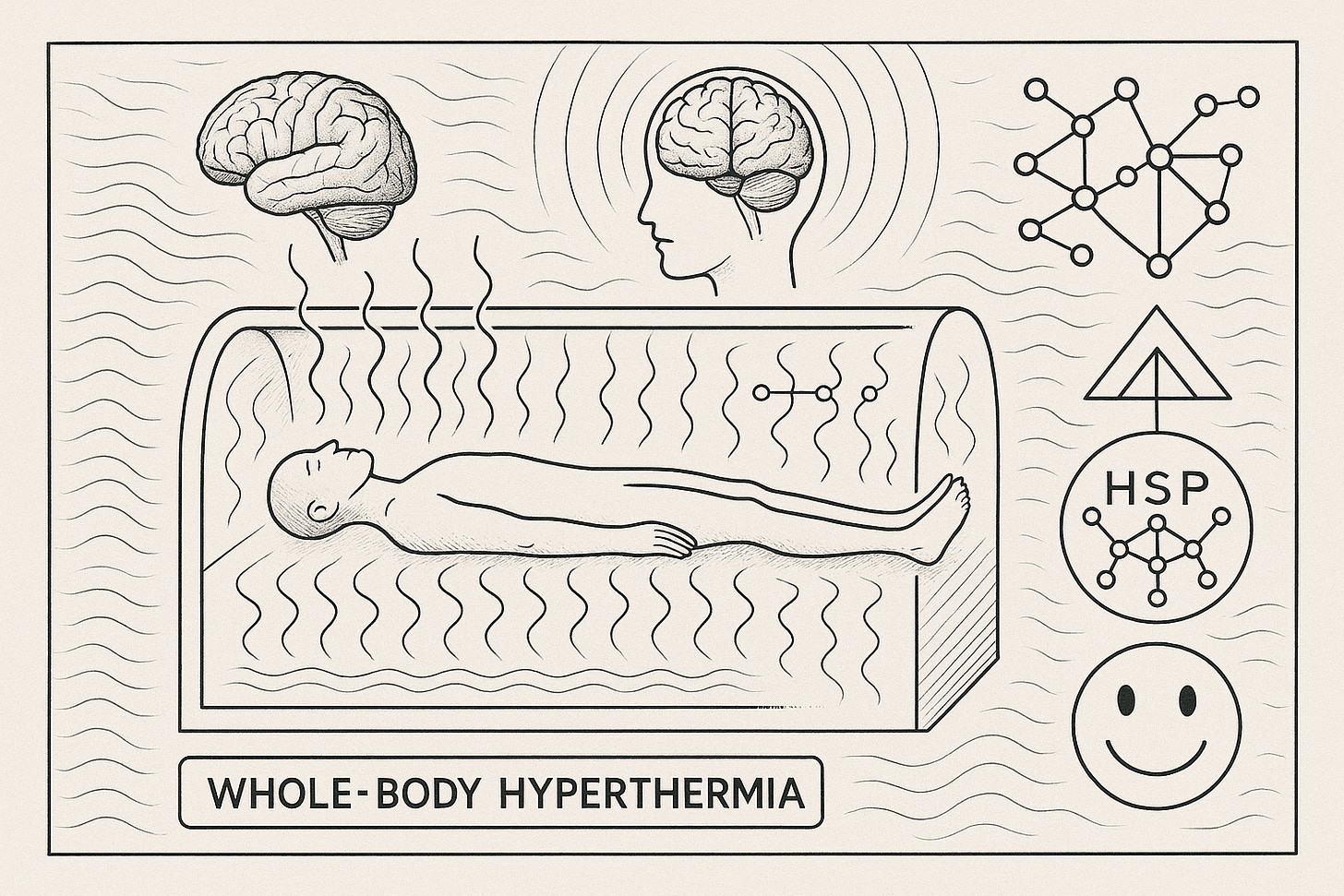Heat Therapy Revolution: How 90 Minutes in a Sauna-Like Chamber Could Transform Depression Treatment
A single session of whole-body hyperthermia shows promise as a rapid-acting antidepressant with effects lasting six weeks.
Have you ever noticed how a warm bath can instantly lift your mood? Scientists at the University of Arizona have taken this everyday observation and transformed it into a potential breakthrough for depression treatment. Their groundbreaking research reveals that a single 90-minute session of controlled whole-body heating could provide relief from major depression that lasts for weeks—without a single pill.
"When compared with the sham group, the active whole-body hyperthermia group showed significantly reduced depression scores across the entire 6-week postintervention study period, with effects apparent within just one week of treatment."
What's the Big Idea?
Researchers discovered that heating the body to a core temperature of 101.3°F (38.5°C) activates specific brain regions involved in mood regulation—the same areas that show decreased activity in people with depression. In this carefully controlled study of 30 adults with major depressive disorder, participants who received the real heat treatment showed dramatic improvements compared to those who received a convincing sham treatment.
The results were striking: depression scores dropped significantly within the first week and remained improved for the entire six-week follow-up period. This wasn't just statistical significance—participants experienced meaningful relief from their symptoms after just one session.
Dr. Rhonda Patrick's pioneering work in popularizing sauna use for depression and cardiac health suddenly makes even more sense. The heat shock proteins our bodies produce in response to thermal stress appear to trigger a cascade of beneficial effects that extend far beyond the treatment session itself.
Why Should You Care?
This research could revolutionize how we approach depression treatment. Current antidepressants often take weeks to work, come with significant side effects, and require daily dosing. Whole-body hyperthermia offers something radically different: a single treatment with rapid onset and prolonged benefits.
For the millions who struggle with medication side effects or simply prefer non-pharmaceutical approaches, this could be game-changing. The treatment mimics something humans have done for millennia—using heat for healing—but with precise, scientific control. As someone planning to incorporate regular sauna sessions this fall, these findings validate what traditional cultures have long known: controlled heat exposure profoundly benefits both mind and body.
The implications extend beyond depression. The same thermosensory pathways activated by this treatment connect to brain regions involved in pleasure, reward, and overall well-being. This suggests potential applications for anxiety, chronic stress, and possibly other mood disorders.
What's Next on the Horizon?
While these results are promising, researchers acknowledge this is just the beginning. Future studies will need to determine optimal heating protocols—would multiple sessions provide even better results? Could lower temperatures be equally effective? What about combining heat therapy with other treatments?
The accessibility question looms large. The study used specialized medical equipment, but could similar benefits be achieved with infrared saunas, traditional saunas, or even hot baths? These are critical questions that need answers before this treatment becomes widely available.
Scientists are also exploring the molecular mechanisms at play. Understanding exactly how heat triggers antidepressant effects could lead to new drug targets or help identify who might respond best to this treatment. The role of heat shock proteins, changes in blood flow, and activation of specific serotonin pathways all warrant deeper investigation.
Safety, Ethics, and Caveats
Before rushing to your nearest sauna, consider the study's limitations. Participants were medically healthy adults without treatment-resistant depression. The controlled medical setting ensured safety monitoring throughout the procedure. Side effects, while generally mild, included headache, fatigue, and nausea immediately after treatment.
The study's modest sample size of 30 participants means we need larger trials to confirm these findings. There's also the challenge of creating truly blind conditions—93% of participants receiving real heat correctly guessed their treatment, potentially influencing results through expectation effects.
Not everyone can safely undergo whole-body heating. People with cardiovascular conditions, pregnancy, or certain medications need medical clearance. The treatment requires careful temperature monitoring to avoid overheating. This isn't something to attempt unsupervised at home with extreme heat exposure.
What This Could Mean for You
If you're intrigued by these findings, consider starting conservatively. Regular sauna use at moderate temperatures (around 170-190°F for 15-20 minutes) has shown benefits in numerous studies and can be safely incorporated into most people's routines with proper hydration and gradual adaptation.
Talk to your healthcare provider about heat therapy, especially if you're currently managing depression. While we await larger trials and standardized protocols, exploring gentler forms of heat exposure—whether through saunas, hot baths, or hot yoga—might offer mood benefits with minimal risk.
For those planning to start heat therapy this fall, like myself, begin slowly. Start with shorter sessions at lower temperatures and gradually build tolerance. Listen to your body, stay hydrated, and never push through dizziness or discomfort. The goal is sustainable, beneficial stress—not extreme endurance.



